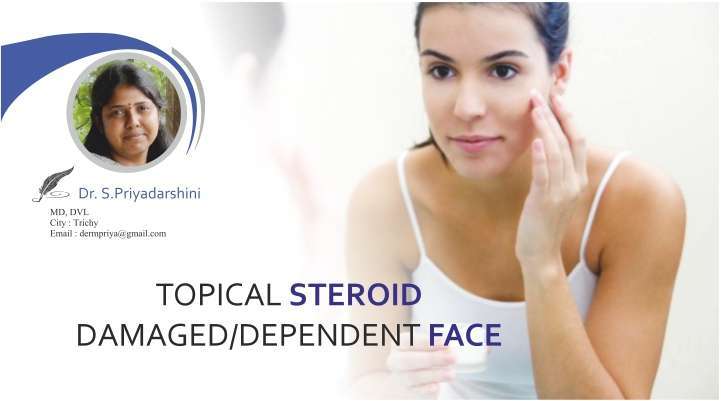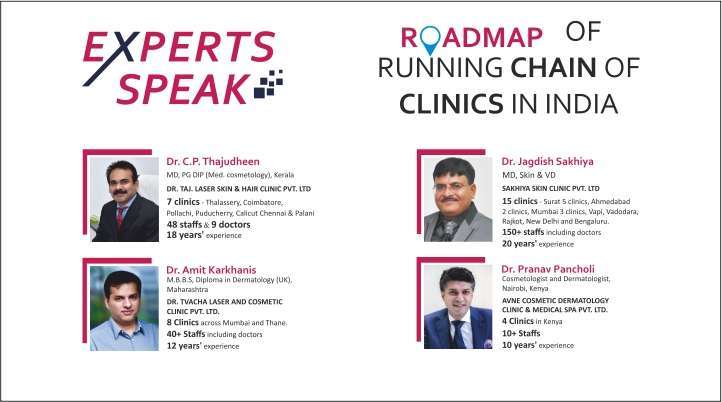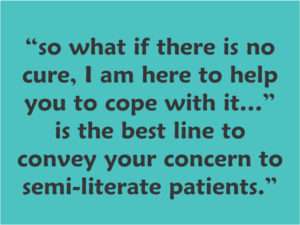After getting amazing feedbacks and comments for Dermatalk’s innovative and insightful segment “Expert speak” where we discuss important aspects with different experts, share their insights and ideas on various important aspects. This section mainly focusses on non medical issues and those which will be immensely useful to our readers.
In this issue, we are privileged to have Dr. C.P. Thajudheen, Dr. Jagdish Sakhiya, Dr. Amit Karkhanis and Dr. Pranav Pancholi as experts to share their precious experience and opinion. A Big thanks to them.
ROADMAP OF RUNNING CHAIN OF CLINICS IN INDIA
Running a chain of clinics is everyone’s dream and desire. However very few have been able to make this dream a reality. These few are definitely doing something right and something different that others are not doing. So, we have chosen 4 highly successful, established and experienced cosmetologists & dermatologists-entrepreneurs from across the India and from Kenya to share their journey to success, the hardships as well as their future plans. Dr. C.P. Thajudheen is definitely the king of south and has a roaring cosmetic practice in Kerala. Dr. Amit Karkhanis has established himself a name in Mumbai. Dr. Jagdish Sakhiya needs no introduction and is on the way to mark a century. Looking overseas we have on board Dr. Pranav Pancholi from kenya and he shares his practice secrets with us here.

Undoubtedly, HUMAN RESOURCE is the most important aspect in success of any business and this applies to cosmetic clinics as well. Being a service industry, training of the staff, their constant development, their grooming and most importantly their retention is a very challenging task.
NOW LET’S HEAR FROM OUR EXPERTS HOW DO THEY DEVELOP & RETAIN THEIR STAFF MEMBERS?
Dr. Jagdish Sakhiya says – to develop and retain our staff we regularly do staff assessment and give regular training both technical and personal development. We do in-house and also invite various faculty from management and related industry persons to train them.

Dr. Amit Karkhanis also add that We have continued staff training program. Responsibility given to them to handle their own respective functions.
Dr. Thajudheen says – we conduct induction class, give them training and awareness about all departments in clinic. We provide positive working atmosphere and regularly take employee opinion survey as well as conduct one on one meeting to discuss the various things. Also, we have good salary package, PF, ESI and insurance. “Appreciation increases employee happiness and satisfaction, it improves company culture” So we appreciate their work regularly. We also communicate our new business mission with our employees.
Dr. Pranav Pancholi – Yes, we do regular training sessions for technical, marketing as well as personal growth for our team. We provide incentive based salary and give commission to motivate them.
AS we know that chain of clinics would be in different cities, states and countries and the no. of clinic would be regularly increasing…so the biggest challenge is
HOW TO RUN AND MANAGE CHAIN OF CLINICS & HOW TO FACE THOSE CHALLENGES?
As per our expert
Dr. Amit Karkhanis says – my biggest challenges, our Clients ask to meet the main Doctors and this requires a proper handling and management.
For that we have proper STANDARD OPERATING PROCEDURES, it is the keys to developing a chain of clinics and maintaining the same.
Dr. Jagdish Sakhiya says our biggest challenges, we face in terms of attachment of medical doctors for long period and also trained staff from same field.
To overcome these challenges, we are maintaining proper relationship & conducting motivational programme. We provide them world’s best facilities, lasers, equipment’s & technologies. We also offer incentive and commission with good package. We provide proper training to our staff as per our field requirement.
Dr. Pranav Pancholi – my challenges to maintain Human resource and mismanagement.
For that we conduct regular staff motivation in terms of various things to develop them and creating system to avoid mismanagement.
Dr. Thajudheen says – Attrition and Pilferage are the biggest challenges with chain of clinics
To overcome, we regular monitoring CCTV in branches very efficiently, and we make doctors involve in all the clinic activities more & more. We offer them good packages, PF, ESI, insurance and appreciation.
Now we want to know from our experts about
2 MAJOR HURDLES WHEN THEY DECIDED TO BRANCH OUT AT THE TIME OF APPROACHING TO OPEN THEIR SECOND CLINIC.
Dr. Thajudheen – My 2 major hurdles were Language & Doctors availability
Dr. Pranav Pancholi says – it was accountability and human resource constraint
Dr. Amit Karkhanis – my major hurdles during branch out were
- Clients identifying the brand with a Doctor.
- Identifying the correct staff and location for the branch expansion
Dr. Jagdish Sakhiya’s 2 major hurdles were to
- Find trained staff at that time
- Long breakeven point.
One very good question to all over experts
IF YOU ARE TO START YOUR JOURNEY AS A DERMATOLOGIST ALL OVER AGAIN WOULD YOU CHOOSE TO OPEN CHAIN OF CLINIC?
Dr. Amit Karkhanis says – Of course. The objectives and results are very different in running an individual clinic and a chain of clinics. Its 2 different ‘games’ so choose wisely and correctly. I enjoy difference challenges and the clinic chain was the second challenge after doing the first one very well. Now we have moved to the 3rd challenge!
Dr. Jagdish Sakhiya also says yes, definitely, I choose to open chain of clinic
Dr. Pranav Pancholi adds – Yes, I choose to even more clinics with set up and systems.
Here as per Dr. Thajudheen’s opinion– yes I chose to open but I would rather go for franchise model.
Going private, consolidation, breaking into new markets with new services – there are all kinds of reasons for companies to Acquire and Merger with the other firms in coming years. Expecting lots of M&A activity that we have seen several big deals signaling new products, services and capabilities coming to the market for our industries.

So according to current scenario, we ask our experts to state their opinion on
“IS THE FUTURE OF DERMATOLOGY PRACTICE MERGERS AND ACQUISITIONS?”
As per Dr. Amit Karkhanis’s opinion – Yes. With corporatization taking place in healthcare, Mergers and Acquisitions would a part of the future, but it will take some time in India, which will for the next 7 years at least always have a market for individual Doctor Clinics in the Dermatology segment.
Dr. Thajudheen’s opinion – Yes, Mergers and Acquisitions will give the synergy in our industry
Dr. Pranav Pancholi – That shall be the case I believe, going forward as the market expands… I plan to buy clinics of retiring doctors.
Dr. Jagdish Sakhiya says – in our dermatology segment Mergers and Acquisitions – not in coming 5 years
We want to know from our experts, about their
10 YEARS FORWARD FUTURE PROJECTION.
Dr. Pranav Pancholi from Kenya – my future projection is, to have an international chain of clinics all across Africa.
Dr. Jagdish Sakhiya says, my future projection is, by 2026, Sakhiya Skin Clinic will have 60,000 square feet corporate office and training center in Surat. We will have our presence in all Tier-I, Tier-II and Tier-III cities on the world map well. Sakhiya Skin Clinic will be leader in Aesthetic Dermatologist and Plastic Surgeries.
Also, we will have our own Sakhiya Remedies Pharmaceutical production unit producing world-class skin and hair care products.

Dr. Amit Karkhanis says – Would not like to specifically comment, but we see ourselves with 150+ clinics across with worldwide operations across 5 continents.
In future, Dr. Thajudheen says I would like to plan Franchise model
TO BRANCH OUT CHAIN OF CLINIC, WHAT ARE THE 2 IMPORTANT CAUTIONS YOU WOULD LIKE TO SHARE WITH YOUNG STARTUPS & FELLOW COLLEAGUES
Dr. Jagdish Sakhiya:
- Updated your knowledge continuously & best patient care
- Patience for long breakeven point & make command fund to take care of any emergency situation.
Dr. Thajudheen shares, “Be ethical & Take time to give proper counseling”
Dr. Amit Karkhanis:
- Do what you enjoy. Technology was something that I was always comfortable with from childhood, so get your comfort zone right in your choice of work. Getting the right technology into my clinic from the early stages was an important piece of our foundation, yours might be something different.
- Innovate Well and always treat all people around you right.
Dr. Pranav Pancholi advices, “Be careful but confident and start slow with a vision to expand”
ONE SINGLE MOST PERSONAL MANTRA, MISSION OR VISION IN ONE SENTENCE.
Dr. Thajudheen:
Professionalism and Ethics
Dr. Pranav Pancholi:
The possibilities in aesthetic dermatology are endless when one has a clear vision and follows the right path.
Dr. Jagdish Sakhiya:
My aim is to provide world class services at affordable price to every Indians.
Dr. Amit Karkhanis:
Work Hard, Play Hard, Constantly Innovate and Always try New Things!
Conclusion…..
We have no doubts that the cosmetic and wellness industry in 2017 is a booming industry and anyone associated in any way with this industry is definitely in the right place. Last decade has seen a tremendous growth in terms of chain of clinics, new technologies, mergers and acquisitions of healthcare giants as well as numerous ecommerce website business flourishing. This era can clearly be marked as the golden period of the cosmetic industry and is here to stay.
What is very characteristic from the above thoughts of the experts is that for all of them, challenges were similar and single most challenge that everyone faces is staff attrition. However they all believe that they were born for this trade and love their work. So for all those established practitioners and even the new comers, in case you have any inkling for running a chain of clinics in future, you need to don your entrepreneur cap and get set.












